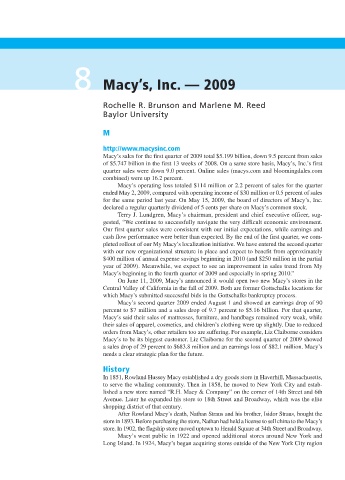Page 487 -
P. 487
8 Macy’s, Inc. — 2009
Rochelle R. Brunson and Marlene M. Reed
Baylor University
M
http://www.macysinc.com
Macy’s sales for the first quarter of 2009 total $5.199 billion, down 9.5 percent from sales
of $5.747 billion in the first 13 weeks of 2008. On a same store basis, Macy’s, Inc.’s first
quarter sales were down 9.0 percent. Online sales (macys.com and bloomingdales.com
combined) were up 16.2 percent.
Macy’s operating loss totaled $114 million or 2.2 percent of sales for the quarter
ended May 2, 2009, compared with operating income of $30 million or 0.5 percent of sales
for the same period last year. On May 15, 2009, the board of directors of Macy’s, Inc.
declared a regular quarterly dividend of 5 cents per share on Macy’s common stock.
Terry J. Lundgren, Macy’s chairman, president and chief executive officer, sug-
gested, “We continue to successfully navigate the very difficult economic environment.
Our first quarter sales were consistent with our initial expectations, while earnings and
cash flow performance were better than expected. By the end of the first quarter, we com-
pleted rollout of our My Macy’s localization initiative. We have entered the second quarter
with our new organizational structure in place and expect to benefit from approximately
$400 million of annual expense savings beginning in 2010 (and $250 million in the partial
year of 2009). Meanwhile, we expect to see an improvement in sales trend from My
Macy’s beginning in the fourth quarter of 2009 and especially in spring 2010.”
On June 11, 2009, Macy’s announced it would open two new Macy’s stores in the
Central Valley of California in the fall of 2009. Both are former Gottschalks locations for
which Macy’s submitted successful bids in the Gottschalks bankruptcy process.
Macy’s second quarter 2009 ended August 1 and showed an earnings drop of 90
percent to $7 million and a sales drop of 9.7 percent to $5.16 billion. For that quarter,
Macy’s said their sales of mattresses, furniture, and handbags remained very weak, while
their sales of apparel, cosmetics, and children’s clothing were up slightly. Due to reduced
orders from Macy’s, other retailers too are suffering. For example, Liz Claiborne considers
Macy’s to be its biggest customer. Liz Claiborne for the second quarter of 2009 showed
a sales drop of 29 percent to $683.8 million and an earnings loss of $82.1 million. Macy’s
needs a clear strategic plan for the future.
History
In 1851, Rowland Hussey Macy established a dry goods store in Haverhill, Massachusetts,
to serve the whaling community. Then in 1858, he moved to New York City and estab-
lished a new store named “R.H. Macy & Company” on the corner of 14th Street and 6th
Avenue. Later he expanded his store to 18th Street and Broadway, which was the elite
shopping district of that century.
After Rowland Macy’s death, Nathan Straus and his brother, Isidor Straus, bought the
store in 1893. Before purchasing the store, Nathan had held a license to sell china to the Macy’s
store. In 1902, the flagship store moved uptown to Herald Square at 34th Street and Broadway.
Macy’s went public in 1922 and opened additional stores around New York and
Long Island. In 1924, Macy’s began acquiring stores outside of the New York City region

